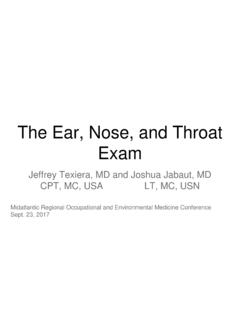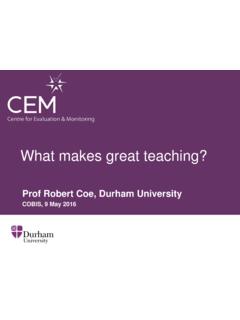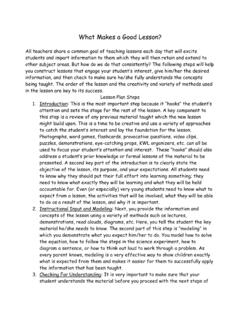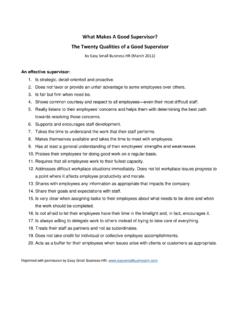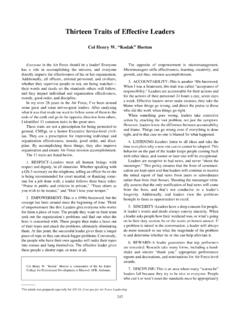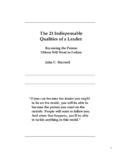Transcription of What Makes Great Teachers Great by Ken Bain
1 From the issue dated April 9, 2004 htm what Makes Great Teachers Great ? By KEN BAIN When Ralph Lynn retired as a professor of history at Baylor University in 1974, dozens of his former students paid him tribute. One student, Ann Richards, who became the governor of Texas in 1991, wrote that Lynn's classes were like "magical tours into the Great minds and movements of history." Another student, Hal Wingo, an editor of People magazine, concluded that Lynn offered the best argument he knew for human cloning. "Nothing would give me more hope for the future," the editor explained, "than to think that Ralph Lynn, in all his wisdom and wit, will be around educating new generations from here to eternity." what did Lynn do to have such a sustained and substantial influence on the intellectual and moral development of his students? what do any of the best professors do to encourage students to achieve remarkable learning results?
2 I and several colleagues from the Searle Center for Teaching Excellence at Northwestern University studied more than 60 professors from various disciplines to try to determine what outstanding Teachers do inside and outside their classrooms that might explain their accomplishments. And when we examined in particular how good Teachers conduct class, we found that they follow several common principles. Specifically, they: Create a natural critical learning environment. "Natural" because what matters most is for students to tackle questions and tasks that they naturally find of interest, make decisions, defend their choices, sometimes come up short, receive feedback on their efforts, and try again. "Critical" because by thinking critically, students learn to reason from evidence and to examine the quality of their reasoning, to make improvements while thinking, and to ask probing and insightful questions. This is, by far, the most important principle -- the one on which all others are based and which commands the greatest explanation.
3 Some Teachers create a natural critical learning environment within lectures; others, with discussions; and still others, with case studies, role-playing, fieldwork, or a variety of other techniques. The method of choice depends on many factors, including the course's objectives, the personalities and cultures of the Teachers and students, and the learning habits of both. But an intriguing question or problem is the first of five essential elements that make up a good learning environment. Often the most successful questions are highly provocative: what would you do if you came home from college and found your father dead and your mother married to your uncle, and the ghost of your father appeared saying that he had been murdered? Why did some societies get in boats and go bother other people, while others stayed at home and tended to their own affairs? Why are some people poor and other people rich? what is the chemistry of life?
4 Can people improve their basic intelligence? The second important element is guidance in helping students understand the significance of the question. Several years ago, we asked Robert Solomon, a philosophy and business professor from the 1 what Makes Great Teachers Great by Ken BainUniversity of Texas, to talk about his teaching to a group of faculty members. Solomon called his talk "Who Killed Socrates?" and in that title captured much of the intellectual energy of his inquiry into Socratic pedagogy and why it isn't used much anymore. When we watched Solomon conduct an introductory philosophy class on epistemology, he simply stood before the freshmen and sophomores, looked them in the eye, and asked, "Does anyone here know anything for sure?" The way he asked the question gave it meaning. As students cast about for a positive answer, reeling in one solution and then another, they began to grasp the purpose of this modern inquiry.
5 Once that happened, their learning could begin. Many Teachers never raise questions; they simply give students answers. If they do tackle intellectual problems, they often focus only on their subject and the issues that animate the most sophisticated scholarship in the field. In contrast, the best Teachers tend to embed the discipline's issues in broader concerns, often taking an interdisciplinary approach. When Dudley Herschbach teaches chemistry at Harvard University, he does so with a combination of science, history, and poetry, telling stories about human quests to understand the mysteries of nature. The lesson on polymers becomes the story of how the development of nylons influenced the outcome of World War II. He even asks his chemistry students to write poetry while they struggle to comprehend the concepts and ideas that scientists have developed. Good Teachers remind students how the current question relates to some larger issue that already interests them.
6 When Solomon taught an advanced undergraduate course in existentialism, he began with a story about life under Nazi rule in occupied France in the early 1940s, reminding students that even ordinary activities like whispering to a friend could have had dire consequences in that police state. Third, the natural critical learning environment engages students in some higher-order intellectual activity: encouraging them to compare, apply, evaluate, analyze, and synthesize, but never only to listen and remember. "I want the students to feel like they have invented calculus and that only some accident of birth kept them from beating Newton to the punch," Donald Saari, a mathematics professor at the University of California at Irvine, told us. Unlike so many in his discipline, he does not simply perform calculus in front of the students; rather, he raises the questions that will help them reason through the process, to see the nature of the questions, and to think about how to answer them.
7 A fourth aspect of a good learning environment is that it helps students themselves answer the question. The professors we studied often raised important inquiries but challenged students to develop their own explanations and defend them. And finally, a good learning environment leaves students wondering: " what 's the next question?" and " what can we ask now?" In the 1990s, the Institute for the Learning Sciences at Northwestern began working with several professors to develop highly interactive multimedia programs that tried to create this natural critical environment. For example, Larry Silver, a professor of art history at the University of Pennsylvania, has developed software called "Is It a Rembrandt?," which engages each student in becoming a museum's top art investigator and determining the authenticity of three of Rembrandt's paintings. To do so, the students must examine the paintings and build a case to support their conclusions.
8 They can inspect each piece of art, compare it to similar works, view the curator's files, or go to the conservation lab. At each turn, they encounter questions, but they decide which ones to pursue, picking their own path through the material. When, for example, the students have been drawn into a close examination of the brushwork on the face of the painting Old Man With a Gorget, they can ask whether Rembrandt's students also mixed brushwork styles in their paintings. If they do, Professor Silver appears on the screen to tell them about "bravura display," and the students can then ask, " what is bravura brush stroke?" 2 what Makes Great Teachers Great by Ken BainSlowly, the students build their understanding of the art world in which Rembrandt worked and of the critics, collectors, scholars, and controversies that have emerged over the years around the work of the Dutch master, his students, and his imitators.
9 They build a vocabulary for thinking about various issues, an understanding of technical details and procedures, and an ability to use a vast array of historical facts. In short, they learn to think like a good art historian, to appreciate the questions that the discipline pursues, to frame important questions of their own, and to determine the kinds of evidence that might help resolve controversies. Gerald Mead, a professor emeritus of French at Northwestern, developed a similar program for his course on the history of modern France called "Invitation to a Revolution," which invites students to travel to the late 18th century to see if they can avoid the excesses of the French Revolution. In Deborah Brown's physics course students can use a program that challenges them to build an elevator. In Jean Goodwin's course on free speech, students can act as Supreme Court justices to decide a tricky actual case that asks whether people can be held legally responsible for the long-range consequences of their speech.
10 We saw the same kind of learning environments created in classes that used simulations, case studies, problems, fieldwork, and even lectures. We saw them when Chad Richardson's students in sociology at the University of Texas-Pan American did ethnographic research on their own cultures, and when Charlie Cannon's landscape-architecture students at the Rhode Island School of Design struggled with how to treat pollution in New York Harbor. Edward Muir, a professor of Italian Renaissance history at Northwestern, recreates trials from that era to help students develop an understanding of the period and how to use evidence to draw historical conclusions. The mathematician Donald Saari takes a roll of toilet paper into class, asks students how they will calculate its volume, then nudges them toward breaking that problem into its simplest components. Jeanette Norden, a professor of cell and developmental biology at Vanderbilt University Medical Center, confronts her students with actual people who have suffered some malady, challenging the future physicians to think through real cases.


